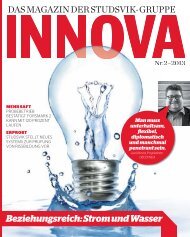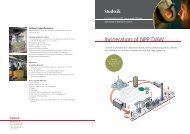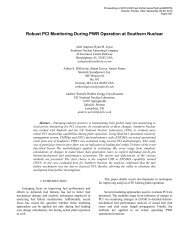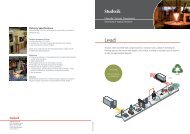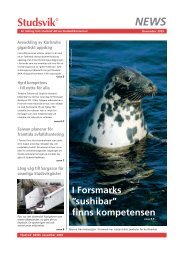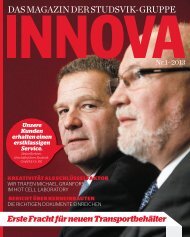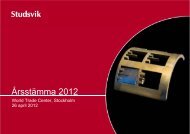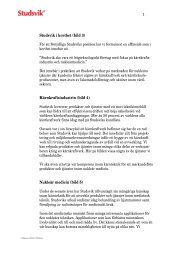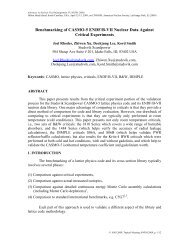Effect of CASMO-5 Cross-Section Data and Doppler ... - Studsvik
Effect of CASMO-5 Cross-Section Data and Doppler ... - Studsvik
Effect of CASMO-5 Cross-Section Data and Doppler ... - Studsvik
Create successful ePaper yourself
Turn your PDF publications into a flip-book with our unique Google optimized e-Paper software.
<strong>Effect</strong> <strong>of</strong> <strong>CASMO</strong>-5 <strong>Cross</strong>-<strong>Section</strong> <strong>Data</strong> <strong>and</strong> <strong>Doppler</strong> Temperature Definitions on LWR Reactivity Initiated AccidentsThe ‘NEA’ definition produces larger pulse widths as noted by other researchers [4]. This effectpartially compensates the lower power peak, <strong>and</strong> the energy generated during the powerexcursion differs only 1% with respect to the ‘BE1’ case.The prompt enthalpy rise is barely affected by the choice <strong>of</strong> the <strong>Doppler</strong> temperature definition.However, the maximum fuel enthalpy could be affected. The under-prediction <strong>of</strong> the <strong>Doppler</strong>reactivity by the ‘NEA’ temperature results in a conservative estimate <strong>of</strong> the peak fuel enthalpy.Table V: Transient parameters: effect <strong>of</strong> the <strong>Doppler</strong> temperature definitionParameterBE1NEABE2GDTLValue Diff (%) Value Diff (%) Value Diff (%)Peak power (MW) 168700 162500 -3.7 167600 -0.7 170200 0.9Peak power time (s) 0.146 0.146 0.0 0.146 0.0 0.146 0.0Pulse width (ms) 18.2 18.7 2.7 18.2 0.0 18.1 -0.5Pulse energy release (MJ) 3070 3039 -1.0 3050 -0.7 3081 0.3Peak power part time (s) 0.1642 0.1647 0.3 0.1642 0.0 0.1641 -0.1Prompt fuel enthalpy (cal/g) 41.81 41.63 -0.4 41.73 -0.2 41.97 0.4Prompt enthalpy rise (cal/g) 24.71 24.53 -0.7 24.63 -0.3 24.87 0.6Peak fuel enthalpy (cal/g) 44.39 51.32 15.6 45.48 2.5 43.72 -1.5Peak enthalpy rise (cal/g) 27.29 34.22 25.4 28.38 4.0 26.62 -2.56. CONCLUSIONSThe effect <strong>of</strong> the cross-section data generated by <strong>CASMO</strong>-5, as well as the impact <strong>of</strong> different effective<strong>Doppler</strong> temperature definitions on LWR RIA was investigated. Key parameters <strong>of</strong> a PWR rod ejectionaccident scenario for a MOX/UO 2 core assuming the known core state have been compared.The main conclusions are: The LWR <strong>Doppler</strong> coefficient predicted using <strong>CASMO</strong>-5 cross-section data is ~10% morenegative at typical HZP conditions. The proper treatment <strong>of</strong> the 238 U resonance elastic scattering is the main contributor to the morenegative <strong>Doppler</strong> coefficient. The use <strong>of</strong> the volume-averaged <strong>Doppler</strong> temperature, Eq. (1), may overestimate the <strong>Doppler</strong>reactivity. The ‘NEA’, Eq. (2), effective <strong>Doppler</strong> temperature definition leads to very conservativeresults because the <strong>Doppler</strong> worth is underestimated ~30% for quadratic pr<strong>of</strong>iles. Temperature distribution effects for <strong>Doppler</strong> could be accurately accounted by the empiricalweighting scheme described by Eq. (4). LWR RIA calculated using <strong>CASMO</strong>-5 cross-section data should be milder. This means that thefuel safety parameters computed with <strong>CASMO</strong>-5 core-section data show more margin than thesame parameters computed using <strong>CASMO</strong>-4 data for PWR rod ejection accidents <strong>and</strong> BWR roddrop accidents. The prompt enthalpy rise is barely affected by the choice <strong>of</strong> the <strong>Doppler</strong> temperature definition.The under-prediction <strong>of</strong> the <strong>Doppler</strong> reactivity by the ‘NEA’ <strong>Doppler</strong> temperature results in aconservative estimate <strong>of</strong> the peak fuel enthalpy. Results computed with the ‘BE1’, ‘BE2’, <strong>and</strong>‘GDTL’ effective <strong>Doppler</strong> temperatures, differ only a few percent.PHYSOR 2010 – Advances in Reactor Physics to Power the Nuclear RenaissancePittsburgh, Pennsylvania, USA, May 9-14, 201011/13



